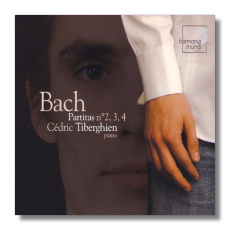
The Internet's Premier Classical Music Source
Related Links
- J.S. Bach Reviews
- Latest Reviews
- More Reviews
-
By Composer
-
Collections
DVD & Blu-ray
Books
Concert Reviews
Articles/Interviews
Software
Audio
Search Amazon
Recommended Links
Site News
 CD Review
CD Review
Johann Sebastian Bach

Keyboard Partitas
- Partita #2 in C minor, BWV 826
- Partita #3 in A minor, BWV 827
- Partita #4 in D Major, BWV 828
Cédric Tiberghien, piano
Recorded Teldex Studio Berlin, August 2004
Released October 2005
Harmonia Mundi HMC901869 77:40
Comparisons: Argerich/DG (no. 2 only), Gould/Sony, Hewitt/Hyperion, Rangell/Dorian, Rubsam/Naxos, Tureck/Philips
Summary: A fine disc, but….
Cédric Tiberghien is a young French pianist who has already recorded Beethoven, Grieg, Schumann, and Debussy for Harmonia Mundi. Tiberghien's Bach is my first acquaintance with his playing, and he certainly has much to offer. His virtuosity and dexterity are never in doubt as he handles Bach's fast movements such as the Courantes and Gigues with aplomb and great energy. Tiberghien also displays an expert balance between upper and lower voices; both his detail and clarity are quite impressive. In addition, he well connects with Bach's lyricism, rhythmic flow, and overall sound world.
However, the disc also reveals two major problems. One concerns the Bach Sarabande which is a standard movement in each of the Suites. This movement is where keyboard players need to put their 'hearts and souls' into music that most possesses great poignancy and alternates between spiritual enrichment and a landscape of bleakness. Playing it at a quick pace tends to trivialize the musical arguments, but playing slower than the norm can also weaken their impact.
Let's use the example of the Sarabande from the Suite in D Major. In most recorded performances, this Sarabande takes up from 8 to 9 minutes; Tiberghien extends the music to about 11-½ minutes. For such a slow pace to be effective, the performance must be more probing and emotionally rich than faster versions and/or offer alternative musical arguments through the use of articulation, dynamics, and accenting; pianists such as Rosalyn Tureck and Wolfgang Rubsam are experts in this area. Unfortunately, Tiberghien merely plays the piece at a slower speed, resulting in music that exhibits much inertia and saps the piece of its stateliness and progression. Since he essentially does nothing with the additional 2-½ minutes, it becomes wasted time and disc space. Of course, this impacts the entire movement and makes it difficult to endure.
The second problem involves a soundstage that 'swims with the fishes'. Overly wet and reverberant, this type of sound might not be very damaging for performances that are strong on horizontal expressiveness, but it is contrary to the concentrated playing style of Tiberghien. Essentially, the playing and soundstage are at odds, robbing the recorded performances of their bite and inevitability.
Don's Conclusions: Given the wrong sonics and unimpressive Sarabandes, I cannot recommend this premium-priced Bach disc from Cédric Tiberghien. It does have its virtues, but the recorded competition is overwhelming. If you like probing accounts, look no further than the Tureck set on a 2CD Philips set. If maximum creativity is your preference, Rubsam's interpretations should delight and illuminate your perception of this music; Rangell's performances are also illuminating but not as distinctive as Rubsam's. Then there's the magnificent set from Glenn Gould and the affectionate readings of Angela Hewitt. Tiberghien does not measure up to these alternatives.
Copyright © 2005/2006, Don Satz




















